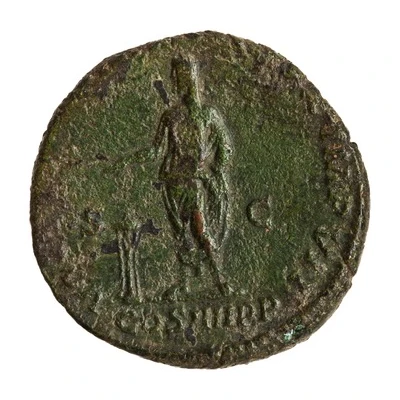As - Commodus P M TR P VIIII IMP VII COS IIII P P S C; Roma and Victory
184 year| Bronze | - | - |
| Issuer | Rome › Roman Empire (27 BC - 395 AD) |
|---|---|
| Emperor | Commodus (Lucius Aurelius Commodus) (177-192) |
| Type | Standard circulation coin |
| Year | 184 |
| Value | As = 1⁄16 Denarius |
| Currency | Denarius, Reform of Augustus (27 BC – AD 215) |
| Composition | Bronze |
| Shape | Round (irregular) |
| Technique | Hammered |
| Demonetized | Yes |
| Updated | 2024-10-06 |
| Numista | N#265808 |
|---|---|
| Rarity index | 100% |
Reverse
Roma, helmeted, draped, standing left, holding Victory in extended right hand and vertical spear in left hand.
Script: Latin
Lettering: P M TR P VIIII IMP VII COS IIII P P S C
Translation:
Pontifex Maximus, Tribunicia Potestate Nona, Imperator Septimum, Consul Quartum, Pater Patriae. Senatus Consultum.
High priest, holder of tribunician power for the ninth time, supreme commander (Imperator) for the seventh time, consul for the fourth time, father of the nation. Decree of the senate.
Comment
Source:Online Coins of the Roman Empire (OCRE)
Interesting fact
One interesting fact about this coin is that it features a rare combination of symbols and letters that reveal the political and religious beliefs of the Roman Empire during the reign of Commodus. The coin's reverse side depicts the goddess Victory standing on the prow of a ship, while the obverse side shows the emperor's bust with a radiate crown, indicating his divine status. The inscription "P M TR P VIIII IMP VII COS IIII P P S C" stands for "Pater Mundi TRibunicia Potestate VIIII Imperator VII COnsecutus IIII Pater Patriae Senatus Consulto," which translates to "Father of the World, Tribunician Power for the seventh time, Emperor for the seventh time, Consul for the fourth time, Father of the Fatherland, by the decision of the Senate." This inscription highlights Commodus's assertive claim to divine authority and his efforts to promote his image as a powerful and benevolent ruler.

